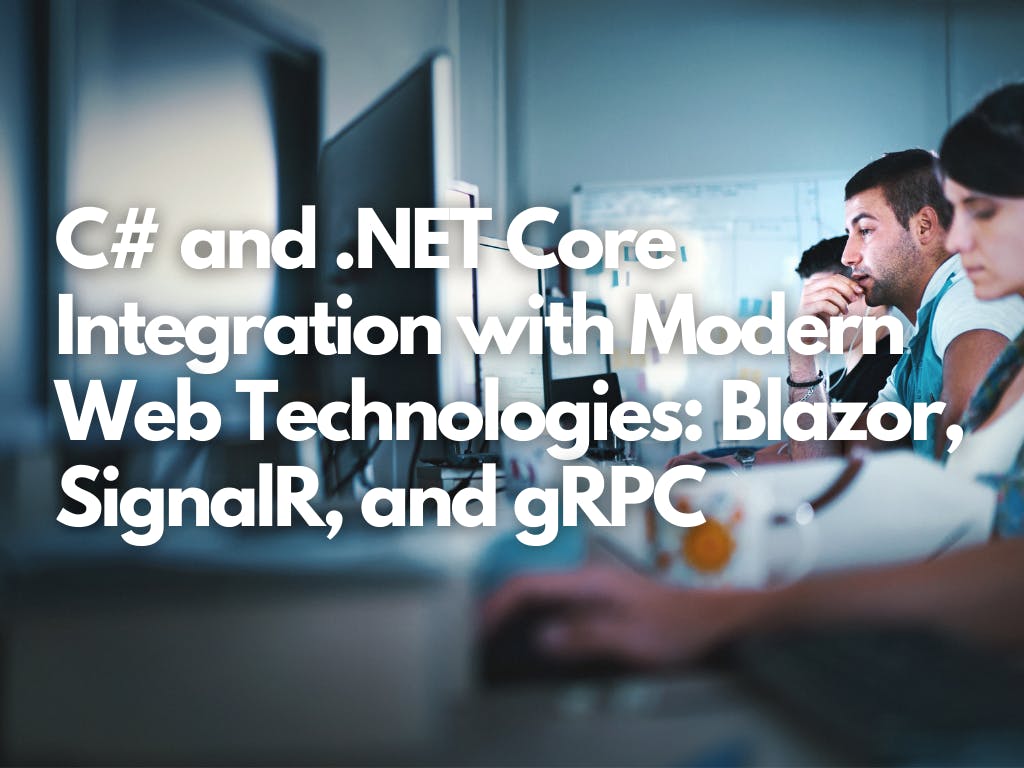In recent years, the software development landscape has seen a paradigm shift, especially in web application development. Modern web technologies have transformed the way developers design, build, and maintain web applications. The rise of C# and .NET Core has played a significant role in this transformation, providing seamless integration with cutting-edge web technologies like Blazor, SignalR, and gRPC.
We will delve into the intricacies of C# and .NET Core integration with these modern web technologies and how they can be used to build robust, high-performance web applications.
Blazor: A Game-Changer for Web Development
Blazor, an innovative web framework by Microsoft, allows developers to build interactive client-side web applications using C# and .NET Core. With Blazor, developers can write both client and server-side code in C#, removing the need to rely on JavaScript for client-side interactivity.
Key Features of Blazor:
- Component-based architecture
- Two-way data binding
- Dependency injection
- JavaScript interoperability
- Server-side rendering with Blazor Server
Blazor offers two hosting models: Blazor WebAssembly and Blazor Server. The former runs client-side in the browser using WebAssembly, while the latter runs server-side with real-time UI updates through SignalR.
To create a simple Blazor WebAssembly application, you can use the following command:
dotnet new blazorwasm -o MyBlazorApp
This will generate a new Blazor WebAssembly project in the MyBlazorApp directory. You can run the app using:
cd MyBlazorApp
dotnet run
Sample Blazor component (Counter.razor):
csharpCopy code@page "/counter"
<h3>Counter</h3>
<p>Current count: @currentCount</p>
<button class="btn btn-primary" @onclick="IncrementCount">Click me</button>
@code {
private int currentCount = 0;
private void IncrementCount()
{
currentCount++;
}
}
For more Blazor resources, visit the official Blazor documentation.
SignalR: Real-time Communication Made Easy
SignalR is a library that simplifies real-time web functionality implementation in .NET applications. It enables server-side code to push updates to clients instantly, allowing for a more interactive and responsive user experience.
Key Features of SignalR:
- Real-time communication between server and clients
- Automatic connection management
- Scalable and extensible
- Cross-platform support
SignalR plays a crucial role in Blazor Server applications, where it establishes a real-time connection between the server and the browser. This connection allows the server to push UI updates to the client, ensuring a smooth user experience.
Here's an example of a simple SignalR hub in a .NET Core application:
using Microsoft.AspNetCore.SignalR;
public class ChatHub : Hub
{
public async Task SendMessage(string user, string message)
{
await Clients.All.SendAsync("ReceiveMessage", user, message);
}
}
And a JavaScript client that connects to the hub and listens for messages:
const connection = new signalR.HubConnectionBuilder()
.withUrl("/chatHub")
.build();
connection.on("ReceiveMessage", (user, message) => {
// Handle received message
});
connection.start().catch(err => console.error(err.toString()));
Explore more about SignalR in the official SignalR documentation.
gRPC: High-Performance Remote Procedure Calls
gRPC is a modern, high-performance, open-source Remote Procedure Call (RPC) framework that can run in any environment. It uses Protocol Buffers as the Interface Definition Language (IDL) for defining the service contract and serializing structured data.
Key Features of gRPC:
- Highly efficient serialization with Protocol Buffers
- Pluggable support for load balancing and authentication
- Bi-directional streaming and flow control
- Language-agnostic and platform-independent
Integrating gRPC with .NET Core allows developers to build high-performance, cross-platform, and scalable microservices. With support for multiple languages, gRPC facilitates communication between services written in different programming languages.
The integration of C# and .NET Core with modern web technologies like Blazor, SignalR, and gRPC has opened new horizons for web application development. These technologies enable developers to create interactive, responsive, and high-performance web applications with ease, leveraging the power of C# and .NET Core throughout the entire development process.
By embracing these cutting-edge technologies, developers can stay ahead of the curve and deliver web applications that meet the ever-evolving needs of modern users.
Here's an example of a simple gRPC service definition using Protocol Buffers:
syntax = "proto3";
option csharp_namespace = "MyGrpcService";
package MyGrpc;
service Greeter {
rpc SayHello (HelloRequest) returns (HelloReply);
}
message HelloRequest {
string name = 1;
}
message HelloReply {
string message = 1;
}
Implementing the service in C#:
using Grpc.Core;
using MyGrpcService;
public class GreeterService : Greeter.GreeterBase
{
public override Task<HelloReply> SayHello(HelloRequest request, ServerCallContext context)
{
return Task.FromResult(new HelloReply
{
Message = "Hello, " + request.Name
});
}
}
To learn more about gRPC and .NET Core integration, refer to the official gRPC documentation.
